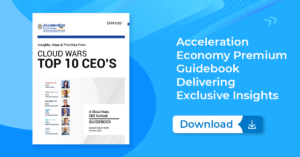
Large and small banks across the globe are joining the cloud revolution in full force as they begin to move their most mission-critical core-banking systems to the cloud, Oracle executive vice-president Mike Sicilia said last week.
In an interview at the New York Stock Exchange during a day-long event celebrating Oracle’s 10th anniversary on the NYSE, Sicilia told me that banks are making a “generational shift” by deploying the cloud not just for their HR departments or consumer apps but for the core systems that require massive levels of scale, speed, and security. (You can check out my full video interview touching on not only Oracle’s work in banking but also other industry-specific insights from Sicilia here.)
Sicilia oversees Oracle’s large and fast-growing Industries business, which provides industry-specific solutions — including core operating technologies — for multiple verticals including healthcare, retail, hospitality, manufacturing, pharmaceuticals/life sciences, utilities, and more. Financial services was among the first verticals that Oracle moved into, and Sicilia said that while bank executives have been understandably hesitant about moving their crown jewels into the cloud, they’re reaching the point where the advantages far outweigh the risk of standing pat.
“Even in the founding days of Oracle, banks were some of the first consumers of the Oracle Database at scale,” Sicilia said. “And when you’re talking about businesses at scale, they’re moving tremendous amounts of data around, and that’s where Oracle shines.”
Eighteen years ago, Oracle intensified its commitment to the banking industry by acquiring an India-based applications company called i-flex for $909 million. At the time, here’s how Oracle chairman (then CEO) Larry Ellison described the deal in a 2005 press release:
“i-flex is the hottest software company in the banking industry, signing more new customers than any other banking software company in each of the last three years,” said Oracle CEO, Larry Ellison. “Banking is a strategic industry for Oracle with 9 out of the top 10 banks already running Oracle ERP applications. Oracle’s overall application strategy is to go beyond ERP and offer customers richer industry-specific functionality. i-flex gets us there in banking.”
And that interplay between ERP and core banking systems is now playing out in the cloud, Sicilia said.
“Three or four years ago, we started to see everybody else’s shift to the cloud for the horizontal applications — ERP, HCM, supply chain — but for banking there was some hesitation with those core banking assets because they’re the heart and soul of what your business is and what you do,” Sicilia said.
“In every industry, there’s a process that it takes for people to get comfortable to move to the cloud — but then all of a sudden, we’re starting to see a real appetite for moving these core assets to the cloud and it’s for the same reasons they move everything else, right?
“There’s elasticity, plus the ability to do more with more because you have more computing power, you’ve got more security, and hopefully more velocity among your employee base.”
I asked Sicilia to go into a bit more detail about the mindsets of Oracle’s banking customers as they make the challenging decisions to begin moving the heart of their business away from the types of systems they’ve depended on for half a century.
“Well, think about what’s happening in particularly the big banks today: there’s a lot of really big iron still running including some mainframes. So it’s not unusual that we’re running into mainframe replacements or, maybe in a best case, they’ve got a minicomputer coming out of here,” Sicilia said.
“So it’s truly a generational shift. And banks were one of the first vertical industries, and they’ve built a lot of software themselves on top of their applications and the result is truly bespoke systems. And like everything else, at some point it becomes very expensive and very non-elastic to maintain these really old systems.”
Compounding those internal challenges are complex external situations that are creating greater levels of uncertainty in an industry that has always sought ultimate predictability.
“The other thing we have going on is lots of geopolitical tensions, lots of uncertainty, and regulatory environments that are changing very quickly. So you have to make a decision about do you want to be in the business of maintaining a bunch of bespoke software and constantly deal with all that stuff? Or would you rather have that provided as a service?”
“And I think,” Sicilia said, “that’s what’s behind this recent change” in customers’ mindsets about the cloud.
Final Thought
Sicilia’s knowledge of key challenges and opportunities across every major industry always makes for some compelling conversations, and I urge you to check out our fast-paced interview here.
Gain insight into the way Bob Evans builds and updates the Cloud Wars Top 10 ranking, as well as how C-suite executives use the list to inform strategic cloud purchase decisions. That’s available exclusively through the Acceleration Economy Cloud Wars Top 10 Course.










